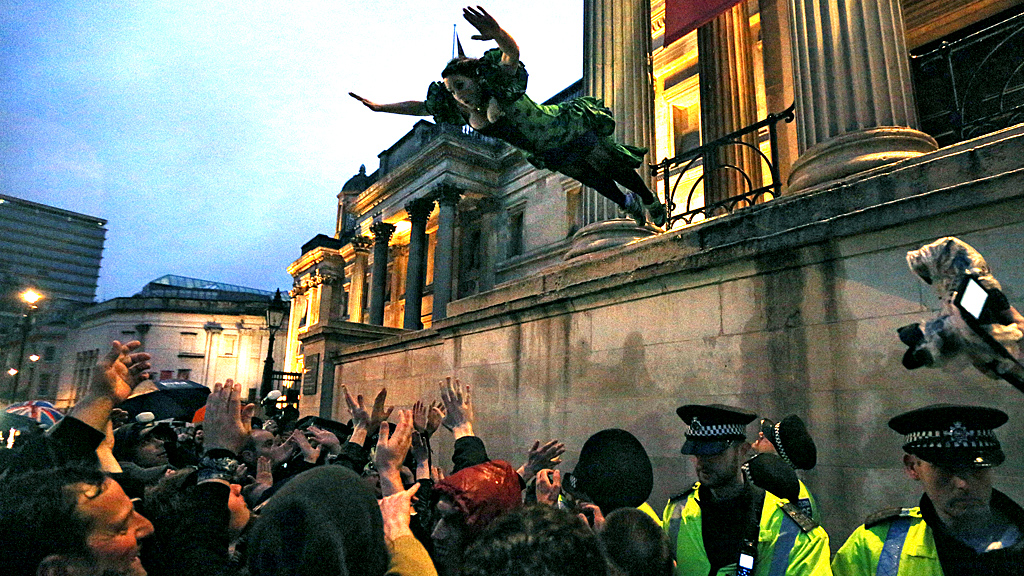Thatcher funeral scale ‘mistake’ says bishop
The Anglican Bishop of Grantham – where Baroness Thatcher was born – questions the scale and cost of her funeral, as details of Wednesday’s service are published.
The Right Reverend Dr Tim Ellis said the event, which could cost up to £10 million was “asking for trouble” – when so many people had negative feelings towards her policies and her legacy.
It was revealed today that Baroness Thatcher’s funeral procession, which will take place on Wednesday, will be accompanied by a single, half-muffled bell toll as the funeral cortege draws up to St Paul’s.
Fourteen Chelsea Pensioners will line the steps as the coffin is borne aloft into the cathedral.
In front of the coffin, Michael and Amanda Thatcher, grandchildren of the former prime minister, will carry cushions bearing the insignia of the Order of the Garter and the Order of Merit and lay them on the Dome Altar.
At the foot of the lectern there will be two modest arrangements of white lilies and greenery. Flowers will ring the candle.
Downing Street said the service will be “framed” by British music, with traditional pieces by great British composers played at the beginning and at the end.
Her love of poetry is reflected in her choice of TS Eliot’s Little Gidding, which will be printed on the opening page of the Order of Service and William Wordsworth’s Ode: Intimations of Immortality on the final page.
David Cameron and Amanda Thatcher will deliver the readings from the King James Bible – of which she was particularly fond.
Read more: Britain 'can afford' Thatcher's funeral says Hague
It was confirmed that the hymns will be He Who Would Valiant Be, Love Divine, All Loves Excelling, Psalm 84 set to the music of Johannes Brahms, and the patriotic verse I Vow To Thee My Country.
The funeral address will be delivered by the Bishop of London, the Rt Rev Richard Chartres.
The presence of the Chelsea Pensioners – the oldest aged 90 – reflects the strong connection Lady Thatcher built up with the Royal Hospital Chelsea over the last 10 years.
Her family has asked that, if people wish to pay their respects, they consider making a donation to the Royal Hospital Chelsea rather than laying flowers.

‘Death party’
Meanwhile hundreds of people partied into the early hours of Sunday at London’s Trafalgar Square to protest against Baroness Thatcher’s legacy.
The revellers chose to mark her death with a party, just hours after the Iron Lady’s daughter Carol made her first public appearance since her mother’s death.
On Saturday evening, Union members from across the UK who had fierce battles with Baroness Thatcher in the 1980s rubbed shoulders with those demonstrating against today’s welfare cuts.
Old and young turned out last night to mark the former prime minister’s death in a “celebration” that they said was many years in the planning.
Read more: Thatcher Ding Dong and the age of the digital protest
Despite the depth of feeling and a large police presence there was no serious trouble and few arrests.
Sixteen people were in police custody – most arrested for being drunk and disorderly – including two arrests for assaulting police officers.
A police spokesman said the last of the protesters left Trafalgar Square at about 2am and there were no reports of any damage to property.
‘Terrible woman’
During the protest people drank cider and champagne, waving sparklers and letting of party poppers and they changed slogans about Lady Thatcher, who died at The Ritz hotel on Monday.
Members of the National Union of Mineworkers travelled to the capital from North East England, with others joining them from Scotland and Wales.
UK Uncut members, protesting about welfare cuts, also joined the demonstration.
One protester, drinking from a mug that read “I still hate Thatcher”, said the event – initially planned by now defunct anarchist group Class War – had been years in the planning.
The 49-year-old, who gave his name only as Steve, said: “I was here during the Poll Tax riot in the 1990s.” He added: “I’ve come from Brighton to be here today. I believe it’s something not to be celebrated, but something that needs to be marked in history.”
Fergus Ray Murray, 34, from north London, made an effigy of Lady Thatcher from recycled materials, which was cheered as he carried it through the crowds. He said: “It’s a chance to lay her to rest as much as possible.”
We’re here to protest about what she’s done and the misery she caused. Fred Reynolds, former union official
Former miner Dave Douglas from Newcastle, part of the delegation from the miners’ union, said Lady Thatcher was a “terrible woman”.
He said: “We’re absolutely furious at this image that is being presented on television – that the whole country is in mourning.
“In the north of England, in Scotland, Wales and the Midlands, people are celebrating the fact she’s gone because we don’t support what she did to our community, our industry and our unions.”
The emotion of the occasion was almost too much for Fred Reynolds, 80, from Sidcup, Kent, who tearfully said: “She destroyed the way of life in our community.”
Read more: FactCheck - the Thatcher myths
Mr Reynolds, who lost his job as a Daily Express union official during Lady Thatcher’s time in power, added: “I don’t want to see any violence at all tonight. What causes the violence is youngsters, who don’t even know what it’s all about, drinking and treating it as a night out. But it’s not. We’re here to protest about what she’s done and the misery she caused in the country, especially for the miners.”
Security was tight, with police officers stationed throughout the square. Scotland Yard said they had an “appropriate policing operation” in place.
The Greater London Authority had also brought in security officers to manage the crowds.